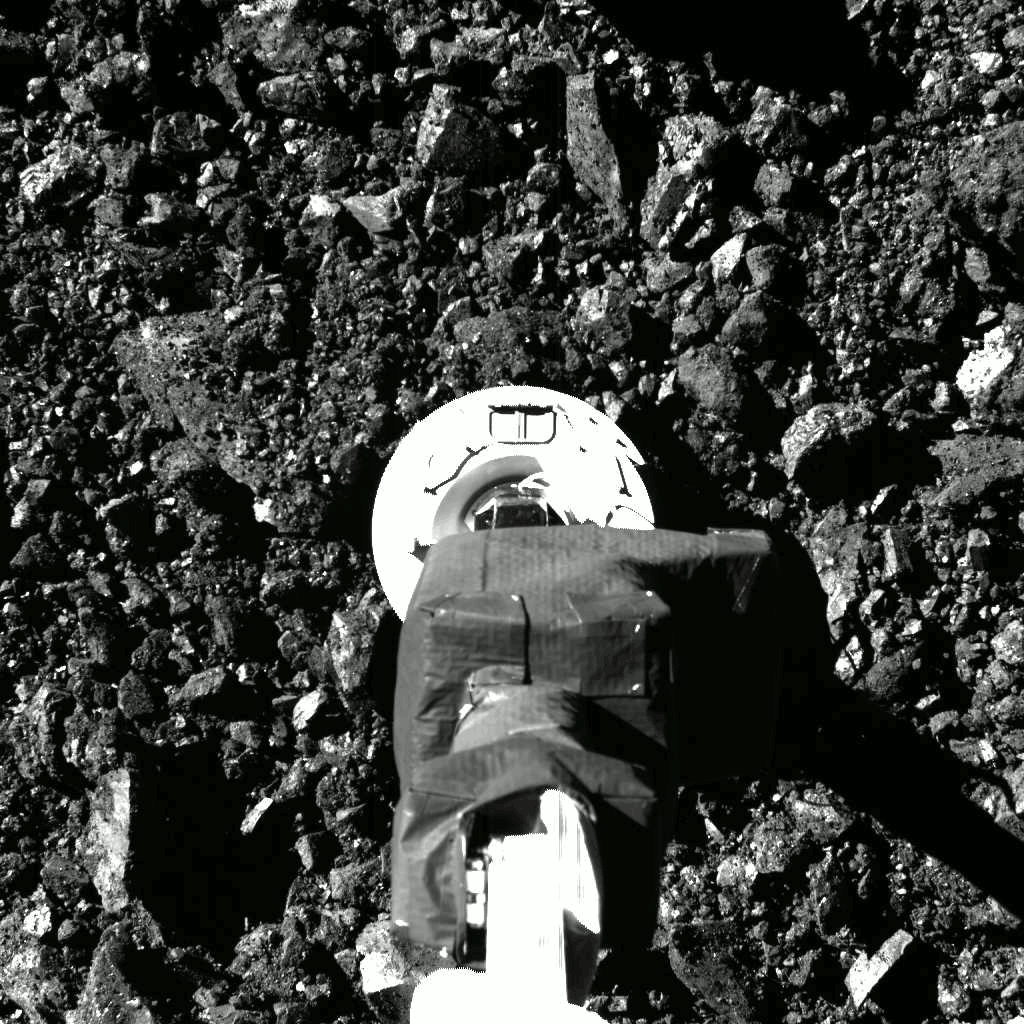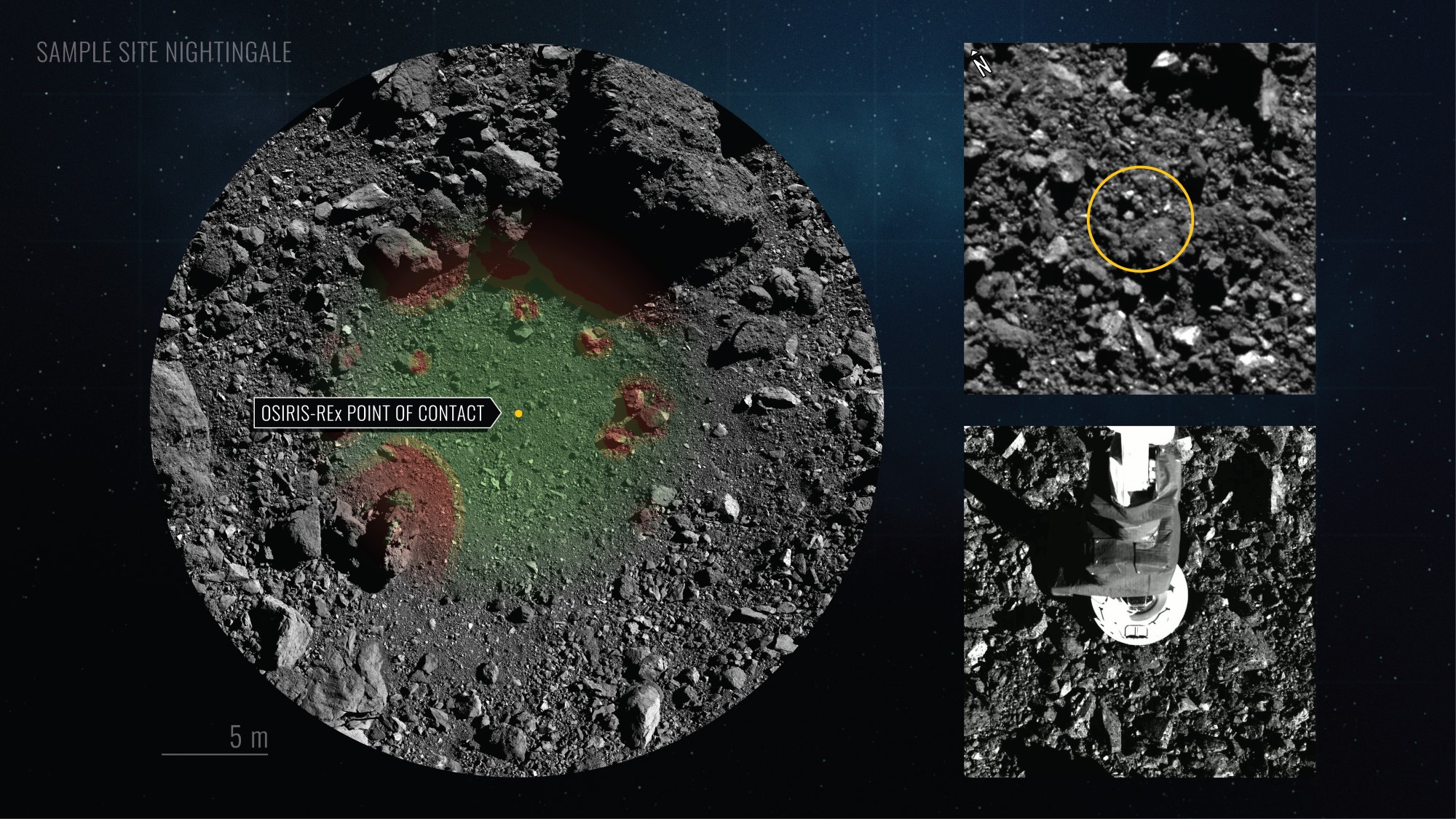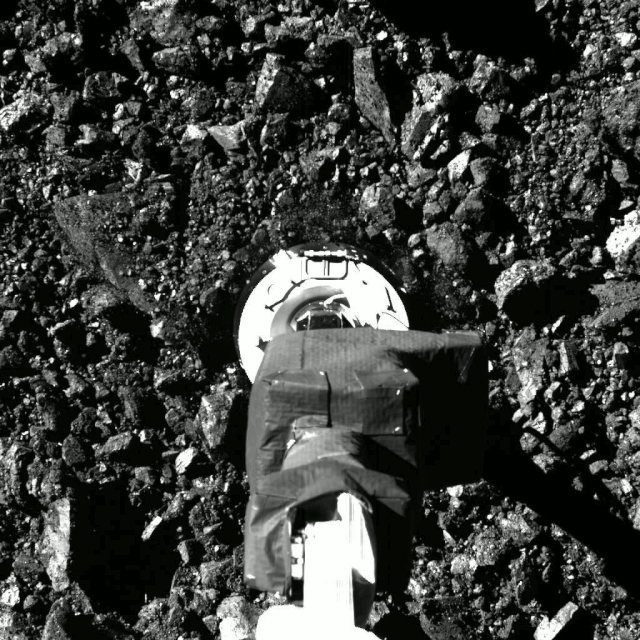NASA's first attempt to sample an asteroid in space made a mess. It's the best mess ever, scientists say.
The OSIRIS-REx probe's encounter with asteroid Bennu appeared flawless.
A NASA spacecraft has really made a mess of things on the asteroid Bennu, and scientists are thrilled.
The spacecraft, NASA's OSIRIS-REx probe, briefly touched down on Bennu Tuesday afternoon (Oct. 21) in the space agency's first-ever attempt to collect samples of an asteroid. It will take time to confirm if OSIRIS-REx did, in fact, collect pieces of Bennu, but so far everything appears to have gone as planned.
"We really did kind of make a mess on the surface of this asteroid. But it's a good mess," OSIRIS-REx principal investigator Dante Lauretta, of the University of Arizona, told reporters from the mission's Lockheed Martin control center in Littleton, Colorado. "It's the kind of mess we were hoping for."
Related: The greatest asteroid encounters of all time!
OSIRIS-REx touched a rocky region of Bennu called Nightingale with a spindly arm tipped with a hubcap-shaped collection plate. At the moment of contact, which lasted just 6 seconds, the spacecraft fired off a puff of nitrogen gas to essentially blow tiny pieces of the 1,640-foot-wide (500 meters) Bennu into its collection device.
It was a high-stakes maneuver for OSIRIS-REx. The spacecraft only has three nitrogen gas canisters, and so three tries, to collect asteroid samples.
During Tuesday's encounter, OSIRIS-REx could have crashed into Bennu, detected a problem and waved itself off or touched the surface but hit a big rock that made snatching smaller particles impossible. Any one of those scenarios could have spelled failure for the $800 million sample-return mission.
Breaking space news, the latest updates on rocket launches, skywatching events and more!
But when the first images reached Earth in the wee hours of this morning, scientists were jubilant.
"The spacecraft's performance was phenomenal," said Sandy Freund, OSIRIS-REx mission operations manager for Lockheed Martin, which built the spacecraft.
The views from OSIRIS-REx showed a successful touchdown, a puff of rocky particles and a smooth departure from the asteroid Bennu. The scientists stitched the images together into an ultra-short video clip capturing the sampling moment, celebrating online in a mission team chat from their respective homes or offices.
"And as you can imagine, the chat was filled with emojis, and wows and all kinds of celebratory remarks," Lauretta said. "Overall, the mood was jubilant because it all looks better than we expected."
Related: NASA's OSIRIS-REx asteroid-sampling mission in pictures
OSIRIS-REx touched down at a gentle speed of 0.2 mph (0.3 kph), pushing into the surface a tiny bit before backing away to a safe distance at a cool 0.9 mph (1.4 kph).
"I must have watched it about 100 times last night before I finally got a bit of shuteye," Lauretta said. "And then I dreamed of a wonder-world of Bennu particles floating all around me."
Any worries of hitting a big, hard rock were abated as OSIRIS-REx appeared to just smash through large chunks about 8 inches (20 centimeters) across.
"Literally, we crushed it," Lauretta said. Some rocks on Bennu appear to be much more pliable or brittle than ones on Earth, he added.
Lauretta's elation is understandable. OSIRIS-REx launched into space in 2016 and reached the asteroid Bennu two years later. In the time since, the spacecraft has set records for orbiting the smallest object yet for a spacecraft, and in the tightest orbit to boot.
And while OSIRIS-REx (the spacecraft's name is short for Origins, Spectral Interpretation, Resource Identification, Security, Regolith Explorer) has revealed tantalizing new details about Bennu (like the discovery of pieces of another asteroid, Vesta, on the surface), returning space rock samples to Earth remains the core mission.
Related: Pieces of heaven: A brief history of sample-return missions
Scientists hope that by studying pieces of Bennu, which is made up of the pristine leftovers from the birth of the solar system, they'll glean new insights into how our cosmic neighborhood formed and how life arose on Earth. They also want to better understand asteroids like Bennu, which can represent a potential impact threat to Earth, to aid planetary defense efforts.
The next step for OSIRIS-REx is to confirm that the spacecraft actually captured samples of asteroid Bennu. To do that, the probe will use a camera to snap pictures of the sample collection plate (called the Touch-And-Go Sample Acquisition Mechanism, or TAGSAM).
The spacecraft will also spin in place with its sample collection arm outstretched to measure any mass difference in the TAGSAM, which will reveal how much sample, if any, was collected. Mission scientists are hoping to collect 2.1 ounces (60 grams) of asteroid Bennu for return to Earth.
If successful, OSIRIS-REx will join an elite club of spacecraft to collect samples of an asteroid. In 2010, the Japan Aerospace Exploration Agency's Hayabusa spacecraft returned pieces of the asteroid Itokawa. A follow-up mission, Hayabusa2, will return samples of a different asteroid called Ryugu in December of this year.
Thomas Zurbuchen, NASA's associate administrator for science missions, compared Tuesday's asteroid sample-collection attempt to a fishing expedition. OSIRIS-REx, he said, did something amazing, but it's only the first step.
"Yes, the line's tight and the sinker dropped and we are excited," Zurbuchen said. "But now we need to bring it in, see where we caught the fish, and then, of course, bring it home."
If all goes well, the samples will be placed in a special capsule for eventual return to Earth in 2023, when OSIRIS-REx makes its way back to our planet. If it turns out that no samples were collected, or perhaps not enough, the mission team could try again in mid-January at a backup landing site called Osprey.
"OSIRIS-REx, in my opinion, is the culmination of human activity as a species. We built this mission for peaceful purposes, out of curiosity, and our desire for knowledge," Lauretta said.
The mission's team members come from diverse backgrounds and viewpoints, he added, "but none of that matters because we work together united in a common vision and a common goal. And when we do that, we achieve amazing things."
Email Tariq Malik at tmalik@space.com or follow him @tariqjmalik. Follow us @Spacedotcom, Facebook and Instagram.

Tariq is the award-winning Editor-in-Chief of Space.com and joined the team in 2001. He covers human spaceflight, as well as skywatching and entertainment. He became Space.com's Editor-in-Chief in 2019. Before joining Space.com, Tariq was a staff reporter for The Los Angeles Times covering education and city beats in La Habra, Fullerton and Huntington Beach. He's a recipient of the 2022 Harry Kolcum Award for excellence in space reporting and the 2025 Space Pioneer Award from the National Space Society. He is an Eagle Scout and Space Camp alum with journalism degrees from the USC and NYU. You can find Tariq at Space.com and as the co-host to the This Week In Space podcast on the TWiT network. To see his latest project, you can follow Tariq on Twitter @tariqjmalik.



